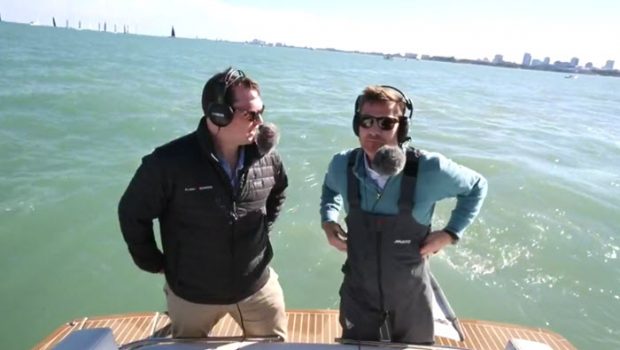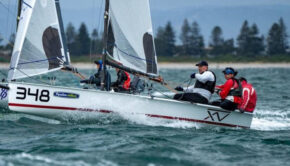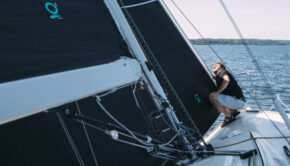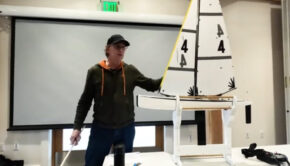Full Broadcast Production on a Budget
Published on November 1st, 2018
For years, live aerial coverage of sailing events was relegated to large grand prix events with deep pocketbooks. However, at the 2018 M32 World Championship in Chicago, local sailing media professional, Matt Knighton, led a team that executed what might be the first ever, multi-drone livestream in the sport.
Knighton, whose pedigree includes winning the Inmarsat Onboard Reporter Award with 2014-15 Volvo Ocean Race Champions, Abu Dhabi Ocean Racing, running Communications for America’s Cup Challenger, SoftBank Team Japan, as well as shooting for Red Bull, Helly Hansen, and many other sports brands, shares the details and lessons learned behind the game-changing livestream:
Arguably, two things have revolutionized small to mid-size regatta coverage in the past two years – Facebook Live and drones. The ability to broadcast live direct into a social media feed and bypass a third-party intermediary has enabled organizers to tap directly into fanbases and drones have changed, well, let’s be honest… what haven’t they changed?
Multi-airborne live coverage of a sailing regatta, even strictly shoreside live production, used to run quotes into the hundreds of thousands of dollars.
However, with the advent of new technology just recently available, the production team I put together to cover the 2018 M32 World Championship sought to try something never before attempted: stream multiple drones into a live broadcast to give unprecedented coverage at a fraction of the cost.
What we ended up with cost only 10% of what a World Match Race Tour live broadcast would have cost with significantly improved aerial coverage.
When we were working on the marketing for 2016 Louis Vuitton America’s Cup World Series Chicago, Event Director Tod Reynolds and I looked at the existing America’s Cup broadcast model and remarked how someday, instead of helicopters, we’ll have a launchpad for four or five drones all taking off and landing to cover the regatta, right in front of the spectators.
In our vision, it would become part of the entertainment for the crowd.
We decided to test this out on a small scale using the M32 World Championship as a test bed with two drones, two commentators, and a director running the show off a media boat anchored on the course.
Using technology that was just released within the past year that enables camera and audio switching on a tablet or laptop using HDMI video sources, we were able to get quickly up to speed beaming the live show using dedicated 5G WiFi hotspots onboard.
Our setup? We used DJI Phantom 4 Pro drones because they balanced relatively long battery life (approximately 20 minutes when flying at high speeds) and safety as its design makes it the easiest drone to catch on the water.
Staggering the takeoffs of two drones for coverage, we were able to overlap batteries and always have a bird in the air. For a safety (and to add color) we also had a third traditional camera dedicated to the presenters.
The coverage was surprisingly easy to orchestrate, and the drones enabled never before seen coverage of a regatta with the livestream beaming shots only meters from the bow of the lead boat around the reach mark.
As expected, battery life is the key. Make sure you have enough for the drones for the race you’re running, as well as the charging capacity to keep re-charging as the day goes on.
Have excellent drone pilots… I cannot stress this enough. In order to push the length of the drone flights, you need pilots experienced with on-water landings and are familiar with advanced airspace management to have situational awareness for not just the race itself, but their position relative to the broadcast boat.
Communications with the crew via headset are also as crucial on a small-budget production as the big ones. Being able to speak to the drone pilots not just for directing coverage but also to relay battery life so you can manage who needs to land when.
Employ a dedicated launch/retrieval assistant. Most of the time we were running drones down until 10-15% battery life,
and at that low-level, your landings are quick. We had an assistant who was a drone pilot himself and knew exactly how to safely catch and launch drones on the water.
Commentators are key. Good talent is hard to come by and by using the broadcast model of a play-by-play and color commentator we were able to keep it moving. With the ability of drones to cover new angles, it’s imperative to not break basic rules of broadcast coverage including where cameras are positioned so as not to confuse the audience. A good commentating team can help smooth this out.
I went into the event with modest-expectations for the live team given how ambitious the new concept was. I think we all came out really proud of the new boundaries we pushed and are more convinced than ever that this is the future of regatta coverage.
Here’s the livestream from the final race of the M32 World Championships:









 We’ll keep your information safe.
We’ll keep your information safe.